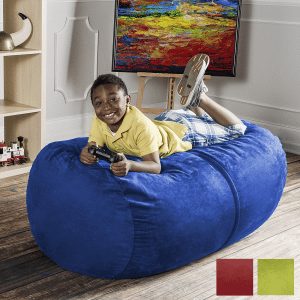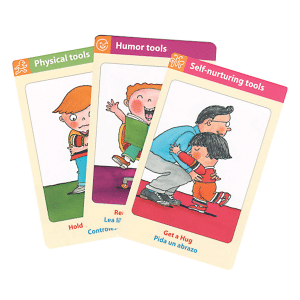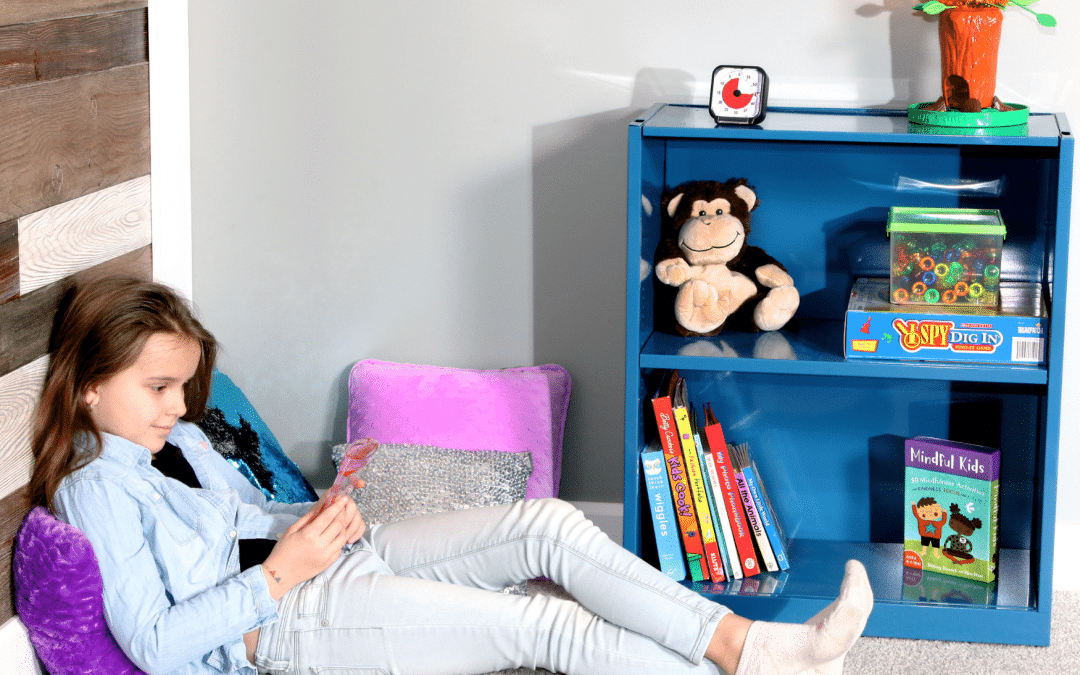Creating a classroom calming corner is great for students who struggle with anxiety, sensory processing challenges, or anyone who needs a break from an overwhelming classroom environment. Below are a few of our favorite tips and tricks for creating a sensory-calming corner for your school classroom:
1. Choose the Right Location for your Calming Corner
- Quiet and Secluded: Select a spot in the classroom away from high-traffic areas. This helps minimize distractions and helps students who experience sensory overload or seek more privacy. Look for a corner or an alcove that can be slightly sectioned off from the rest of the classroom. Consider installing Noise Dampening Tiles to help dampen sounds.
- Accessible: Select a location that is easily accessible for all students, including those with mobility issues. Consider proximity to the main learning area to make it easy for students to transition to and from the calming corner without causing a disruption.
2. Design with Comfort in Mind
- Soft Seating: Include comfortable seating options like our Lounger Beanbag Chairs or a Calming Sensory Canoe. The goal is to create a cozy and inviting space where students feel safe and comfortable.
- Textures and Colors: Use calming colors like blues and greens. These colors have been shown to have a soothing effect. Incorporate different textures with rugs, weighted blankets/lap pads, and sensory pillows to create a multi-sensory experience that can help students relax and unwind.

3. Incorporate Sensory Tools into the Classroom Corner
- Fidget Toys: Provide a variety of fidget toys, such as stress balls, Thinking Putty, Tangle Fidgets, Bendeez, or gel timers to help students self-regulate. Fidget toys are great for promoting focus, concentration, decreasing stress, increasing awareness of fingers/hands (through proprioceptive input), and keeping fidgeting fingers busy.
- Visual Aids: Use calming visuals like our Sensory Gel Timers, Mindful Breathing Pup Light, Color Changing Light Strips, Classroom Light Filters, Sensory Fidget Tubes, or Fiber Optic Lights for providing tactile input and alerting/calming visual stimulation that can help children self-regulate while also reducing stress and anxiety.
- Noise-Reducing Tools: Offer sensory earmuffs, earplugs or white noise machines to help students who are sensitive to loud noises or are trying to increase focus.
4. Add Mindfulness and Relaxation Resources
- Books and Cards: Include a selection of books, calming cards, and tracing discs that promote relaxation and mindfulness. A few of our favorites include Self-Calming Cards, Mandala Labyrinth Tracing Discs, Mindful Kids Cards, Calming Lazy 8 Tracing Stickers, and Simple Mindful Practices for Everyday Life.
- Breathing Exercises: Display posters with simple breathing exercises or provide cards with guided imagery scripts. Our Mindful Breathing Pup Light is also fantastic for calming through controlled breathing exercises.
- Music: Have a small selection of calming music or nature sounds available through a small speaker or headphones. Music can have a powerful effect on mood and can help students relax and focus.

5. Establish Clear Guidelines
- Usage Rules: Clearly explain when and how students can use the calming corner. This might include a signal or a pass system to prevent overcrowding. Make sure students understand that the space is a tool for them to use when they need a break.
- Time Limits: Set reasonable time limits to ensure that all students have access when needed. This helps prevent one student from monopolizing the space and ensures fair usage.
- Respectful Use: Teach students to respect the space and the materials, including cleaning up after themselves.
6. Involve Students in the Process
- Student Input: Involve students in the creation and maintenance of the calming corner. This can increase their sense of ownership and respect for the space. Ask for their ideas on what items to include and how to arrange the space.
- Personalization: Allow students to personalize the space with their own artwork or favorite calming tools. This can help make the space fit their individual needs.
Setting up a calming corner in your classroom can benefit students by offering them a specific area to cope with stress and emotions. By implementing these tips, you can create a welcoming calming corner that helps students succeed in the classroom.
More articles you might enjoy:
10 Best Handwriting Tools for School Classrooms
The Benefits of Sensory Seating in Classrooms
THE BENEFITS OF NOISE DAMPENING TILES FOR SENSORY ROOMS AND CLASSROOMS
27 Classroom Fidget Toys for Kids
©2024 Therapy Shoppe® Incorporated. All rights reserved.


